CONCERT HALLS
In Vienna music is at home: the Musikverein.
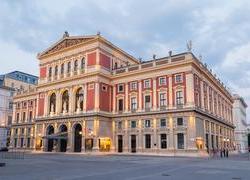
Musikverein Vienna:
Musikvereinsplatz 1, 1010 Vienna
The Musikverein was inaugurated by Emperor Franz Joseph in 1870.
Since then the Golden Hall in the Musikverein is known by friends of music all over the world, not only because of the annual worldwide broadcast of New Year’s Concert by the Vienna Philharmonics, but also for being permanent seat of the Vienna Philharmonics and main stage of the Vienna Mozart Orchestra.
The Golden Hall fascinates the concert guests being a unique architectonic and acoustic master piece.
The Golden Hall in the Musikverein is air-conditioned.

Musikverein Vienna, Golden Hall
Everything in best harmony: the Brahms Hall
The Danish-Austrian architect Theophil von Hansen (1813 – 1891) created with the Brahms Hall in Musikverein the ideal frame for the perfect music enjoyment. Since the restoration after the original plans the Brahms Hall in the Musikverein displays his by visitors from all over the world admired, original beauty in full splendour.
On account of its excellent, world-famous acoustics the Brahms Hall is a frequent venue of the Vienna Mozart Concerts.
The Brahms Hall is equipped with air-condition.
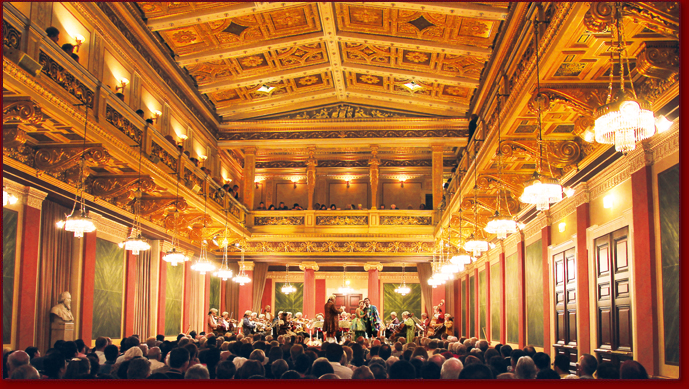
Musikverein Vienna, Brahms Hall
History of the Viennese Musikverein
Wiener Musikverein, (English: “Viennese Music Association”), commonly just quoted The Musikverein, has a twofold meaning: it is the name of its famous Vienna concert hall, as well as the short name for the music society, Gesellschaft der Musikfreunde [Society of Music Lovers] which owns the building.
This building is located on Dumbastraße behind the Imperial Hotel, between Bösendorferstraße and Karlsplatz. However, because Bösendorferstraße is such a small street, the building is better known as being between Karlsplatz and Kärntner Ring (part of Ringstraße loop). The back of the building faces Canovagasse.
History
The concert hall was built by the Gesellschaft der Musikfreunde Wien, on a piece of land given by Emperor Franz Joseph, and it was opened on January 6, 1870. A historic organ was installed in it by the Austrian firm Rieger, in 1907. The Musikverein is famous for its acoustics and is considered to be one of the three finest concert halls in the world, along with Boston’s Symphony Hall and Amsterdam’s Concertgebouw. It is the home to the Vienna Philharmonic.
Architecture
The Große Musikvereinssaal, or Goldene Saal (Golden Hall), is forty-eight metres long, nineteen metres wide, and eighteen metres high. It has 1,744 seats and standing room for 300.
Every year, the Vienna New Year’s Concert is held here.
Since 2001, the building has been undergoing renovation,
and several new rehearsal and concert halls have been installed.
© Wikipedia, 2010
Vienna on the top: the Vienna State Opera House
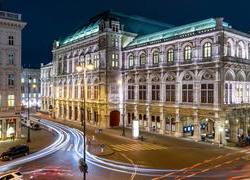
Vienna Opera:
Opernring 2, 1010 Vienna
The Vienna State Opera House was opened in 1869 with a gala performance of Mozart’s “Don Giovanni”. Since that time, it has been one of world’s leading and most famous opera houses. Great musicians have held the post of director, among them Gustav Mahler, Richard Strauss, Herbert von Karajan, Karl Böhm, Lorin Maazel and many others.
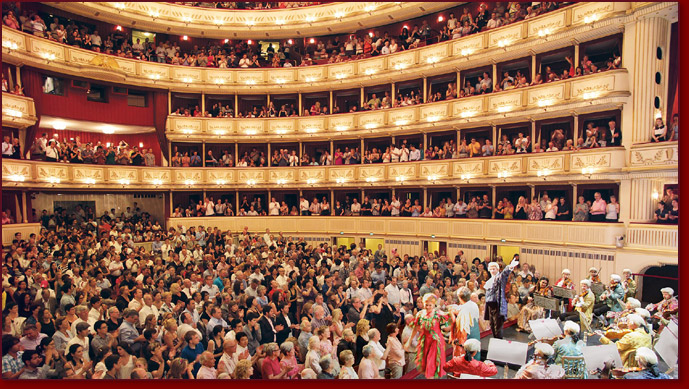
State Opera
History of Vienna State Opera
The Vienna State Opera (Wiener Staatsoper) is an opera house – and opera company – with a history dating back to the mid-19th century. It is located in the centre of Vienna, Austria. It was originally called the Vienna Court Opera (Wiener Hofoper); in 1920, it was renamed the Vienna State Opera. The members of the Vienna Philharmonic are recruited from its orchestra.
History of the Building – Construction
The building was the first major building on the Wiener Ringstraße commissioned by the controversial Viennese “city expansion fund”. Work commenced on the building in 1861 and was completed in 1869, following plans drawn up by architects August Sicard von Sicardsburg and Eduard van der Nüll, who lived together in the 6th district. It was built in the Neo-Renaissance style. This was the first opera built in Vienna.
The building was, however, not very popular with the public. On the one hand, it did not seem as grand as the Heinrichshof, a private residence which was destroyed in World War II (and replaced in 1955 by the Opernringhof). Moreover because the level of Ringstraße was raised by a metre in front of the opera house after its construction had begun, the latter was likened to "a sunken box" and, in analogy to the military disaster of 1866 (the Battle of Königgrätz), was deprecatingly referred to as “the Königgrätz of architecture”. Van der Nüll committed suicide, and barely ten weeks later Sicardsburg suffered a fatal heart attack so neither architect saw the completion of the building. The opening premiere was “Don Giovanni” by Mozart, on May 25, 1869.
Towards the end of World War II, on March 12, 1945, the opera was set alight by an American bombardment, which was intended for the Raffinerie in Floridsdorf. The front section, which had been walled off as a precaution, remained intact including the foyer, with frescoes by Moritz von Schwind, the main stairways, the vestibule and the tea room. The auditorium and stage were, however, destroyed by flames as well as almost the entire décor and props for more than 120 operas with around 150,000 costumes. The State Opera was temporarily housed at the Theater an der Wien and at the Vienna Volksoper.
Lengthy discussions took place about whether the opera house should be restored to its original state on its original site, or whether it should be completely demolished and rebuilt, either on the same location or on a different site. Eventually the decision was made to rebuild the opera house as it had been.
Present day
The Vienna State Opera is closely linked to the Vienna Philharmonic, which is an incorporated society of its own, but whose members are recruited from the orchestra of the Vienna State Opera.
The Vienna State Opera is one of the busiest opera houses in the world producing 50 to 60 operas per year in approximately 200 performances. It is quite common to find a different opera being produced each day of a week. As such, the State Opera employs over 1,000 people. As of 2008, the annual operating budget of the State Opera was 100 million Euros with slightly more than 50 % coming in the form of a state subsidy.
The opera company operates a repertoire system: more than 50 productions are staged every year, and there is a performance nearly every day for ten months of the year.
© Wikipedia, 2010
Vienna traditional and modern: the Konzerthaus
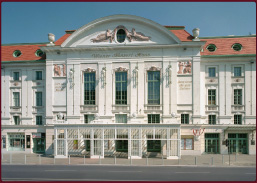
Vienna Konzerthaus:
Lothringerstraße 20, 1030 Vienna
The Wiener Konzerthaus was completed in 1913 during the reign of Emperor Franz Joseph and thoroughly renovated from 1998 to 2000. Today it is the seat of the Viennese Symphony Orchestra, which plays many concerts there throughout the year.
Important festivals such as the Viennese Music Weeks “Wiener Festwochen” take place in the Konzerthaus.
The Konzerthaus is equipped with all modern technical convenience , such as air-conditioned.
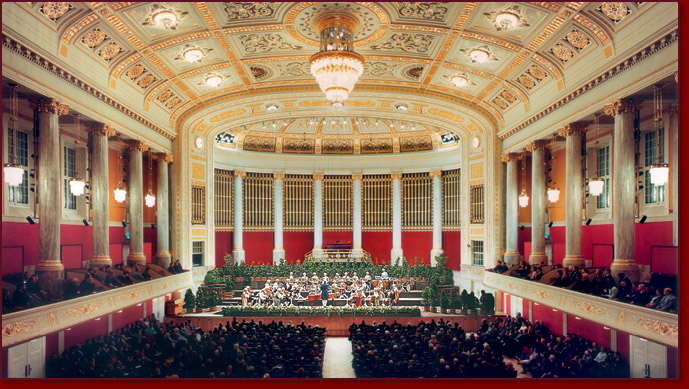
Great Hall
History of the Konzerthaus Vienna
The Konzerthaus in Vienna (in German language: Wiener Konzerthaus) was opened 1913. It is situated in the third district just at the edge of the first district in Vienna. Since it was founded it has always tried to emphasise both tradition and innovative musical styles.
History of Construction
In 1890 the first ideas for a Haus für Musikfeste came about. The idea of the new multi purpose building was to be more interesting to the broader public than the traditional Wiener Musikverein. In addition to the concert hall, the first drawings by Ludwig Baumann for the Olympion included an ice-skating area and a bicycle club. In an attached open air area 40,000 visitors would be able to attend events. The drawings were not accepted. However, today an ice skating area is situated right next to the building.
The Konzerthaus was finally built between 1911 and 1913. The architects were Ferdinand Fellner and Hermann Helmer (Büro Fellner & Helmer); the work was done in cooperation with Ludwig Baumann.
Performance facilities
The building is about 70x40 meters and had originally three halls, in which there can be simultaneous concerts, since they are sound-proofed. The original art nouveau building was partly destroyed during renovations and adaptions, but the building was reconstructed from original sketches in the 1970s. A historic organ was installed in the Konzerthaus by the Austrian firm Rieger in 1913. Between 1997 and 2000 the house was completely renovated.
Großer Saal, with 1,840 seats.
Mozartsaal, with 704 seats.
Schubertsaal, with 336 seats.
Program
The Konzerthaus has the Vienna Symphony Orchestra, the Wiener Kammerorchester, the Wiener Singakademie and the Klangforum Wien in residence. Several subscriptions also include concerts by the Vienna Philharmonic Orchestra and other organizations.
The Wiener Konzerthausgesellschaft also conducts several Festivals during the year.
Early Music Festival Resonanzen in January
The Spring Festival Wiener Frühlingsfestival
The Internationale Musikfest in May and June
Wien Modern in the Fall
© Wikipedia, 2010
